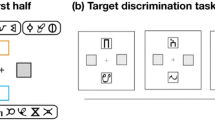Abstract
This experiment determined whether superstitious spatial variability would occur when experimental contingencies specified only the numerical dimensions of behavior. Six college students participated in a task in which icon changes were contingent on depressions of a button. A randomly selected number of unavoidable failures to change the icons alternated across the experiment with blocks of five consecutive unavoidable successes. Unnecessary changes in the location of the cursor persisted for three participants at high frequency after failures of button depressions to change the icons. The findings were related to discussions about the prevalence and functions of superstition in the variation and selection of human behavior.
Similar content being viewed by others
References
ANTONITIS, J. J. (1951). Response variability in the white rat during conditioning, extinction, and reconditioning. Journal of Experimental Psychology, 42, 273–281.
BOREN, J. J., & DEVINE, D. D. (1968). The repeated acquisition of behavioral chains. Journal of the Experimental Analysis of Behavior, 11, 651–660.
BOREN, L. J., MOERSCHBAECHER, J. M., & WHYTE, A. A. (1978). Variability of response location on fixed-ratio and fixed-interval schedules of reinforcement. Journal of the Experimental Analysis of Behavior, 30, 63–67.
BRUNER, A., & REVUSKY, S. H. (1961). Collateral behavior in humans. Journal of the Experimental Analysis of Behavior, 4, 349–350.
CATANIA, A. C., & CUTTS, D. (1963). Experimental control of superstitious responding in humans. Journal of the Experimental Analysis of Behavior, 6, 203–208.
CERUTTI, D. T. (1991). Discriminative versus reinforcing properties of schedules as determinants of schedule insensitivity in humans. The Psychological Record, 41, 51–67.
DONAHOE, J. W., BURGOS, J. E., & PALMER, D. C. (1993). A selectionist approach to reinforcement. Journal of the Experimental Analysis of Behavior, 60, 17–40.
ECKERMAN, D. A., & LANSON, R. N. (1969). Variability of response location for pigeons responding under continuous reinforcement, intermittent reinforcement, and extinction. Journal of the Experimental Analysis of Behavior, 12, 73–80.
ELDRIDGE, G. D., PEAR, J. L., TORGRUD, L. J., & EVERS, B. H. (1988). Effects of prior response-contingent reinforcement on superstitious behavior. Animal Learning and Behavior, 16, 277–284.
EPSTEIN, R. (1985). The spontaneous interconnection of three repertoires. The Psychological Record, 35, 131–141.
FENNER, D. (1980). The role of contingencies and ‘principles of behavioral variation’ in pigeons’ pecking. Journal of the Experimental Analysis of Behavior, 34, 1–12.
GLEESON, S., LATTAL, K. A., & WILLIAMS, K. S. (1989). Superstitious conditioning: A replication and extension of Neuringer (1970). The Psychological Record, 39, 563–571.
HIGGINS, S. T., MORRIS, E. K., & JOHNSON, L. M. (1989). Social transmission of superstitious behavior in preschool children. The Psychological Record, 39, 307–323.
JUSTICE, T. C., & LOONEY, T. A. (1990). Another look at “superstitions” in pigeons. Bulletin of the Psychonomic Society, 28, 64–66.
LATTAL, K. A. (1974). Combinations of response-reinforcer dependence and independence. Journal of the Experimental Analysis of Behavior, 22, 357–362.
LEE, V. L. (1994). Organisms, things done, and the fragmentation of psychology. Behavior & Philosophy, 22, 7–48.
LEE, V. L. (1995). What is a psychological unit? Behaviour Change. 12, 98–108.
MORGAN, D. L., MORGAN, R. K., & TOTH, J. M. (1992). Variation and selection: The evolutionary analogy and the convergence of cognitive and behavioral psychology. The Behavior Analyst, 15, 129–138.
NEURINGER, A. J. (1970). Superstitious key pecking after three peck-produced reinforcements. Journal of the Experimental Analysis of Behavior, 13, 127–134.
NOTTERMAN, J. M. (1959). Force emission during bar pressing. Journal of Experimental Psychology, 58, 341–347.
ONO, K. (1987). Superstitious behavior in humans. Journal of the Experimental Analysis of Behavior, 47, 261–271.
PAGE, S., & NEURINGER, A. (1985). Variability is an operant. Journal of Experimental Psychology: Animal Behavior Processes, 11, 429–452.
RILLING, M., KRAMER, T. J., & ASKEW, H. R. (1970). A preliminary analysis of the dynamics of the pecking response in pigeons. Journal of the Experimental Analysis of Behavior, 13, 267–278.
SCHOENFELD, W. N., HARRIS, A. H., & FARMER, J. (1966). Conditioning response variability. Psychological Reports 9, 551–557.
SCHWARTZ, B. (1982). Reinforcement-induced behavioral stereotypy: How not to teach people to discover rules. Journal of Experimental Psychology: General, 111, 23–59.
SKINNER, B. F (1948). “Superstition” in the pigeon. Journal of Experimental Psychology, 38, 168–172.
SKINNER, B. F. (1978). Reflections on behaviorism and society. Englewood Cliffs, NJ: Prentice Hall.
SKINNER, B. F. (1981). Selection by consequences. Science, 213, 501–504.
STADDON, J. E. R. (1975). Learning as adaptation. In W. K. Estes (Ed.), Handbook of learning and cognitive processes. Vol. 2. Conditioning and behavior theory. Hillsdale, NJ: Lawrence Erlbaum.
STADDON, J. E. R., & SIMMELHAG, V. L. (1971). The “superstition” experiment: A reexamination of its implications for the principles of adaptive behavior. Psychological Review, 78, 3–43.
TIMBERLAKE, W., & LUCAS, G. A. (1985). The basis of superstitious behavior: Chance contingency, stimulus substitution, or appetitive behavior? Journal of the Experimental Analysis of Behavior, 44, 279–288.
VOGEL, R., & ANNAU, Z. (1973). An operant discrimination task allowing variability of reinforced response patterning. Journal of the Experimental Analysis of Behavior, 20, 1–6.
WAGNER, G. A., & MORRIS, E. K. (1987). “Superstitious” behavior in children. The Psychological Record, 37, 471–488.
WEISBERG, P., & KENNEDY, D. B. (1969). Maintenance of children’s behavior by accidental schedules of reinforcement. Journal of Experimental Child Psychology, 8, 222–233.
ZEILER, M. D. (1972). Superstitious behavior in children: An experimental analysis. In W. K. Reese (Ed.), Advances in child development and behavior (pp. 12–29). New York: Academic Press.
Author information
Authors and Affiliations
Additional information
Preparation of this article was supported by Australian Research Council Grant Number A79331585 for the project entitled “Act-based Reformulation of Behavior Change Research.”
Rights and permissions
About this article
Cite this article
Lee, V.L. Superstitious Location Changes By Human Beings. Psychol Rec 46, 71–86 (1996). https://doi.org/10.1007/BF03395164
Published:
Issue Date:
DOI: https://doi.org/10.1007/BF03395164




